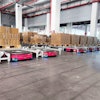
For leaders in manufacturing and distribution across the United States, the list of headaches is piling up with each passing day - they’re understaffed, overwhelmed, short on critical equipment and supplies and dealing with long wait times to get what they need. Facilities are realizing they need less on their plate each day and many are turning to automation to optimize their operations in hopes of simplifying their work. The challenge along the way however is that they are bypassing the low hanging fruit in their existing material handling equipment -- their forklift power system.
Is this really a surprise? The continued efficiency and usefulness of key equipment, such as forklifts and reach trucks, is an assumed given. We take them for granted in the same way we take for granted the lights will come on when flicking a switch. And when that switch is flicked, we tend to forget that there is an intricate power system operating in the background.
This is the biggest mistake manufacturers and distributors make today. Forklift power is the No. 1 limitation in most facilities right now. It is a business killer. It’s an unseen and rarely contemplated problem. Most companies either throw more batteries at the problem, or are choosing new technologies to solve it, but is that the optimal solution? There is nothing worse for an employee than coming to work and having their computer or their IT system or their forklift not work. Today, addressing power (i.e. battery and charger system) issues is reactive. In short, managers wait until there’s a serious problem and then they try to quickly patch it up.
Forklifts are a Top 3-5 expense in high velocity facilities, and the power behind the forklifts equates to almost half of that expense.
It’s a significant contributor to downtime cost due to a Frankenstein approach to forklift power, including mismatched batteries and chargers, mis-sized equipment and an over-reliance on operator compliance to fix a badly designed battery system. Exacerbating this further, even world-class operations have little more than a basic battery maintenance program in place. Most systems are hanging precariously on the “set it and forget it” model or the “cross your fingers” approach.
Let’s face it, forklift power has not been on your radar. This failure to consider and implement a solution specifically for proactive forklift power has never been more of a problem than it is today with forklift equipment lead times extending to 18-24 months. In the past, customers hid forklift power issues with short leases, flipping equipment often. That approach to forklift power won’t work when we start holding onto equipment for longer periods of time—not to mention the enormous safety and downtime risks we continue to allow in our facilities.
Forklift power management is best described in a side-by-side comparison of real world examples:
Company A has taken the reactive power management approach that most in the industry take.
They wait for downtime issues to occur, identify the problem in the forklift power source and put a band-aid on the problem. Because this solution is temporary (and poorly designed), the issues persist and become continuous, popping up and stopping operations again and again. Each time another band-aid is applied, more resources are tied up. As these situations recur, the costs mount, and there’s no way to predict what they’ll inevitably be. Power data is collected after problems occur, or not at all, so the operations manager is always on their backfoot, attempting to keep up and understand what’s going on. Or worse yet, the lack of any data means the true nature of the problem is never actually revealed. The forklift power system is analog and not responsive, meaning it doesn’t dynamically shift based on the needs of the operation. Everyone is constantly playing catch up to try to make things work.
Company B has invested the time, resources and energy in a proactive plan for power management.
They preempt issues, promptly identifying and addressing root causes behind power problems. Long wait times driven by current supply chain concerns is a non-issue because the equipment isn’t in need of major intervention in the first place. This approach drives up productivity with less downtime and higher asset uptime. As a result, costs are lowered significantly, both in terms of longer asset life and lower energy costs. In fact, most companies see a 30% savings when they implement a proactive forklift power management system. Finally, the whole system is data-driven, which provides a continuous loop for self-monitoring and efficiency improvement.
When you’ve had a chance to witness the effects of a reactive approach to power management, it boggles the mind to consider why anyone would choose this path.
Having seen this failure across the industry, leaders should rethink their approach and usher in a new era of proactive power management. Perhaps this is a do-it-yourself system led by a planned maintenance provider tasked with delivering an executive summary of potential power issues and corrective actions. Or it could be the implementation of a set of battery sensors and charging applications to deliver raw data for monitoring. It might entail an integrated technology solution that manages the entire forklift power system automatically and cohesively, or some combination of all three of these options.
Whichever option feels appropriate for your business - what matters is that you take action now. Don’t wait for a problem to arise. Don’t put a band-aid on the problem and hope for the best. Learn from the mistakes of others and adopt a proactive approach to this common concern.

















